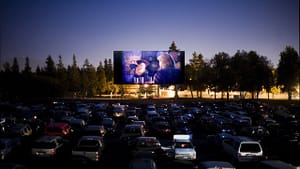Stay in the Loop
BSR publishes on a weekly schedule, with an email newsletter every Wednesday and Thursday morning. There’s no paywall, and subscribing is always free.
Starry night
Drive-ins and the way we watch movies

Sometime before you could instantly watch movies recently released in theaters at the click of a button (in the comfort of your own living room) and sometime after you could only catch a movie through peering into a homemade machine on a street corner, there was a brief era in American cinema history that completely changed the way we watched movies: the era of the drive-in theater.
That era is not completely gone.
The Experience
Rows of cars line up in perfect semicircles facing the big blank gray screen. For $9.00 a person, it’s already better than most movie theaters, and when you throw in the double feature, it’s a pretty good deal. Hatches and truck beds pop open, pouring out kids and coolers. You can tell who’s been there before and who hasn’t. The pros come early with chairs, blankets, snacks, and toys, setting up their area like a well-practiced ritual. First-timers come with just a car, and they peer out their windows, a bit unsure of the environment.
It’s like tailgating before a sporting event, but for movie junkies. People talk about last week’s movie and cheer on their favorite actors — but instead of peanuts, popcorn seems to be the snack of choice. Kids run around hopped-up on Jujubes and soda. Car engines roaring and headlights still shining, it doesn’t seem to be the perfect setting to watch movies. Then, as the sun sets and the screen lights up, the kids disappear and the talking ceases. The engines shut off, and the neon lights around the concession stand go out. A few cheer with excitement. Now the stage is set.
As we sat in our car, the Universal logo began to play, but no sound was heard. We realized we had to turn up our speakers — yeah, we were the first-timers. After fumbling with the car radio for a few minutes, we set the correct station and the sound was working and coming in clear. Several minutes into the movie, Transformers: Age of Extinction, I wished the sound was back off. Luckily for you this isn’t a movie review.
How we watch movies
It occurred to me that this is the way movies should be viewed — socially, around large groups of people. That’s what gives them life. It’s how they breathe. A movie without an audience is like a pastor without a congregation. They need to speak to someone, otherwise they’ll die out.
Popular art like Transformers and other summer blockbusters are great to watch socially. These movies have the philosophy that the more people you have watching them the better they are, and it’s true. Watching Back to the Future or Psycho alone will have a completely different feel than when viewed with a group.
Art films also thrive on an audience, maybe even more so, because they are meant to be discussed and debated. Watching with a group and exchanging views and contrasting ideas open windows you wouldn’t see if you watched it by yourself.
The more things change . . .
Movie theaters will always be around. Michael Moore said it best, “People have kitchens but they still go out to eat. There are still restaurants.” However, new technology allows multiple viewing opportunities. Many reasons like accessibility and convenience, and the big one, money, help feed into this cultural shift. We have so many outlets to watch movies that if you waited a month or so after a theatrical release, you can find it pretty much anywhere — on demand, online, at your local Redbox, and even on your phone.
I’m not saying it doesn’t make sense to do this — I do it too. It’s easy and cheap, but you lose something. You lose the participation and the involvement. Remember the days of going to Blockbuster and searching up and down the aisles, touching all the DVD cases? (Are you old enough to remember the VHS boxes?) Those days are long gone. Now you can have any movie you desire at the touch of your fingertips.
What if we did the same thing to famous works of art? Instead of walking around the museum, each spot having its designated picture, what if you could just scroll through all of them within seconds? It would be pretty easy, but what does it do to the quality of the art? Something is lost. It can’t be as appreciated as it should.
All art forms require a specific space or a particular setting to be viewed in. For movies, that place is the movie theater or drive-in. There is something to be learned in an environment where people can gather together and be fully submerged in the magic.
The drive-ins had it right. Seeing a movie should be a shared experience. If you have the time, take a trip to one of these forgotten outdoor theaters. Step back in time. If you like movies as much as I do, I promise you will not regret it.
What, When, Where
Most of the local drive-ins are gone, but the Delsea Drive-In Theatre in Vineland, NJ shows first-run movies on two screens.
A list of Pennsylvania drive-ins is available here.
Sign up for our newsletter
All of the week's new articles, all in one place. Sign up for the free weekly BSR newsletters, and don't miss a conversation.